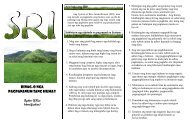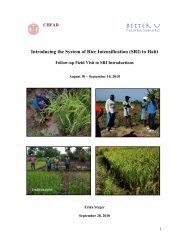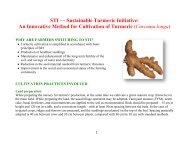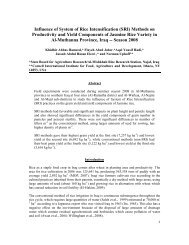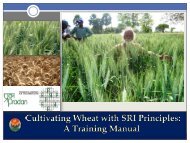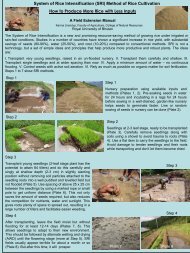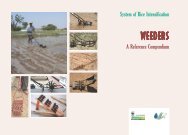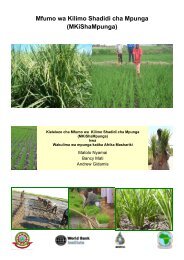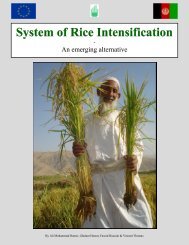EFFECT OF THE SYSTEM OF RICE INTENSIFICATION (SRI) ON ...
EFFECT OF THE SYSTEM OF RICE INTENSIFICATION (SRI) ON ...
EFFECT OF THE SYSTEM OF RICE INTENSIFICATION (SRI) ON ...
You also want an ePaper? Increase the reach of your titles
YUMPU automatically turns print PDFs into web optimized ePapers that Google loves.
consuming due to larger spacing and a longer timeframe until closure of the canopy which will<br />
enhance weed growth (Dobermann, 2004). Anthofer (2004) states that for <strong>SRI</strong> trials in Cambodia<br />
farmers saved labour time during transplanting as seedlings were easier to uproot and transplanting<br />
fewer plants per field saved time as well, although first time, <strong>SRI</strong> practising farmers needed more<br />
time for this. Tong et al. (2007) reports that in average it takes 60-70 people to transplant a<br />
conventional/traditional rice field of 1 ha. By only transplanting 1 seedling instead of several, it is<br />
probably possible to decrease the number of people needed for transplanting dramatically.<br />
Anthofer (2004) states that for weeding the amount of labour increased within <strong>SRI</strong> trials from<br />
Cambodia. It is however expected that when farmers are more experienced with <strong>SRI</strong> techniques the<br />
amount of labour will decrease (Prasad, 2006) and <strong>SRI</strong> can become a labour saving technique<br />
(Satyanarayana et al., 2007). The work load relating to compost production and transporting it to<br />
the fields might however be a constraint for converting all fields to <strong>SRI</strong>, especially those located far<br />
from the homestead land which is typical in Cambodia.<br />
As a response to the factors illustrated in figure 12 on why farmers would like to continue they were<br />
also questioned on how big an area they would plan to conduct <strong>SRI</strong> on for next year’s crop season.<br />
At present farmers grow in average 534 m 2 with <strong>SRI</strong> and next year the average area is 3676 m 2 .<br />
Table 7 illustrates this year’s and next year’s percentage of <strong>SRI</strong> of the farmers’ total land.<br />
Table 7. Present and 2009 percentage of <strong>SRI</strong> of total agricultural area.<br />
% <strong>SRI</strong> of total<br />
land<br />
2008 2009<br />
5 (+ - 9) 24 (+ - 27)<br />
The increase in land area with <strong>SRI</strong> corresponds to an increase of almost 20% which is quite an<br />
increase. It is however questionable if the farmers will be able to produce enough compost for next<br />
year’s <strong>SRI</strong> crop. This is discussed further in subsection 9.5.4<br />
All the participating farmers in the study would as mentioned want to continue with <strong>SRI</strong>, but in<br />
most cases the farmers will not be able to increase <strong>SRI</strong> production unlimited to all their land due to<br />
lack of enough compost or money for chemical fertilizers. Moser and Barrett (2003) found that the<br />
disadoption rate of <strong>SRI</strong> was higher amongst farmers with lower incomes in Madagascar. Barrett et<br />
al. (2004) suggest that poor farmers in Madagascar have difficulties to afford the interseasonal<br />
credit needed to conduct <strong>SRI</strong> as they cannot afford to use family available labour on <strong>SRI</strong> as they are<br />
58



